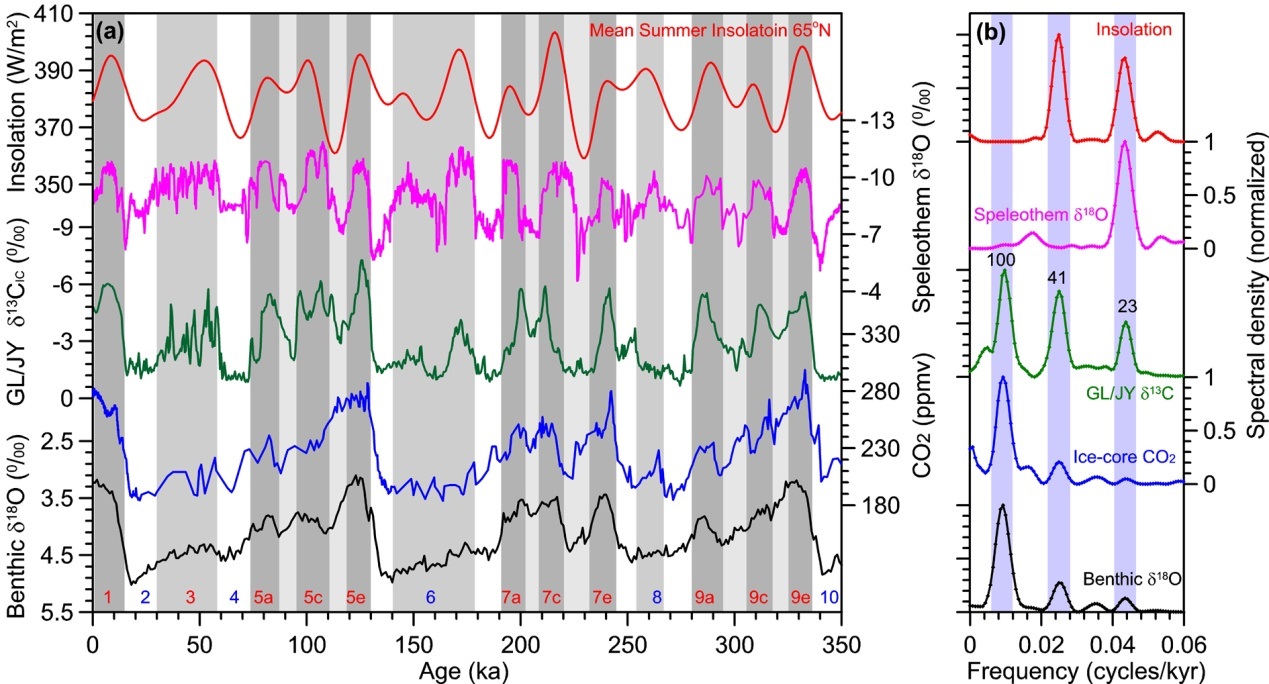A recent paper has been published in Quaternary Science Reviews entitled ‘Astronomical and glacial forcing of East summer monsoon variability’ by Dr. SUN Youbin of the Institute of Earth Environment, Chinese Academy of Sciences and an international team of co-authors from Joint Center for Global Change Studies, University of Wisconsin-Madison, Brown University, and Institute of Atmospheric Physics, Chinese Academy of Sciences. The research demonstrates that East Asian summer monsoon (EASM) variability was induced by integrated effects of the summer insolation and changing boundary conditions, such as ice sheets and CO2 concentration.
Monsoon circulation is an essential driver of hydrological changes in the low-to-mid latitudes of both hemispheres; therefore, understanding monsoon variability from the natural past to the anthropogenic future is critical for both scientific communities and policy makers. Many proxy indicators of paleomonsoon variability reflect some aspect of changes in rainfall and wind, such as Chinese loess and speleothem records. However, these monsoonal proxies display a considerable range of variability in amplitude, phasing, and relative concentrations of variance within the primary frequency bands. Moreover, numerous sensitivity experiments with differing boundary conditions have been conducted to identify the response of EASM variability to various forcing factors, but differentiating the relative influence of insolation and coupled ice-sheet and CO2 concentration remains unclear.
Youbin Sun and his coauthors investigated a sensitive summer precipitation proxy (δ18CIC) from two high resolution loess sequences, Gulang (GL) and Jingyuan (JY), on the northwestern Chinese Loess Plateau, and depicted that EASM demonstrates significant 100 kyr, 41 kyr, and 23 kyr periodicities, implying integrated effects of global ice volume, solar radiation, and CO2 concentration on EASM changes (Fig.1). The coupled ocean-atmospheric model CCSM3 was further adopted to address the relative sensitivity of the summer precipitation changes for the south and north China to the above three driving forces; the results show that the relative impacts are spatially different, with a stronger insolation effect in south China and a more dominant ice/CO2 influence in north China (Fig.2).
Youbin Sun and his coauthors further suggested that a thorough understanding of past monsoon variability and dynamics, particularly regarding the CO2 impact, could provide increased confidence in projections of future precipitation changes in monsoon-affected regions.

Fig.1 Time series (a) and spectral results (b) of monsoonal proxies, summer insolation, CO2 and benthic δ18O stack.(Image by SUN Youbin et. al )

Fig.2 CCSM3-simulated differences in summer precipitation and 850 hPa wind vectors between Early Holocene-Pre Industrial (left), and LGM-Pre Industrial. Dashed rectangles indicate North China (33-42oN, 100-120oE) and South China (24-33oN, 100-120oE).
Further details from Dr SUN Youbin: sunyb@ieecas.cn, State Key Laboratory of Loess and Quaternary Geology, Institute of Earth Environment, CAS.
The research was supported by funds from the National Basic Research Program of China (2013CB955904), the Chinese Academy of Sciences (XDB03020504 and KZZD-EW-TZ-03), and the National Science Foundation of China (40921120406 and 41472163).
 © 2015 Institute of Earth Environment,CAS
© 2015 Institute of Earth Environment,CAS Address:No. 97 Yanxiang Road, Xi'an 710061, Shaanxi, China

 Location :
Location :